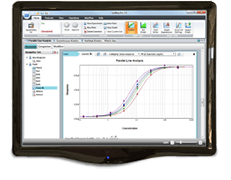

SoftMax Pro Software
The most published microplate reader control and data analysis software
Preconfigured protocols and custom assay workflows simplify microplate data acquisition and analysis
SoftMax® Pro Software for Windows 10 and 11 is designed to provide the simplicity, flexibility and power required for advanced data analysis. It provides ready-to-run protocols, analysis algorithms, and 21 different curve fit options. Every step is optimized for data acquired from a Molecular Devices microplate reader or data imported from another source to simplify analysis and reporting. Compliance tools are available for regulated laboratories providing end-to-end chain of custody.

Simplify data measurement
The software offers a variety of options to initiate the measurement of a microplate assay through prewritten protocols with included acquisition settings or by setting custom experiment parameters.

Import and analyze complex data
Import raw data in microplate format acquired from any scientific instrument, consolidate data reduction from diverse data sources, and reduce errors with consistent data evaluation methods.

Publish like a pro
The software includes tools to publish reports with flexible data output formats. Data can be viewed in a lab notebook layout, saved as a PDF file, exported to an Excel file or to XML for LIMS integration.
Features

Built-in protocols
Use over 160 protocols with preconfigured assay parameters for a wide variety of common assays including protocols for our entire suite of reagents, SpectraTest® Validation Plates, and adapter plates.

Advanced reader control
Build custom assay workflow, run multitask kinetics, and pause and resume kinetic reads with the discontinuous kinetics feature.

Flexible calculations
Data analysis features are available such as 21 different curve fit options, simplified cross-plate analysis and interpolation, and automatic calculations of relative potency, EC50, and Z factors.

Project management made easy
Group multiple plate reads in one protocol. Display results, conditional pass/fail statements, mini graphs, and images in the notes section for easy viewing of overall project results.

Secure electronic record keeping
Controlled user access is provided through a granular permission structure and unique logins with electronic signature support for verification, authorization, and approval, including audit trails.

Validation tools reduce cost
Extensive suite of microplate reader validation tools can reduce the cost and time of validation by 50% when compared to using multiple platforms to collect and analyze data.
Latest Resources
Customer Breakthrough
Specifications & Options of SoftMax Pro Software
Helpful Tips:
- To prevent data loss, turn off all sleep and hibernation settings for the hard disk, the CPU, and the USB ports
- Disable automatic Windows Updates
- Update WIndows manually when the instrument isn't being used by the software; these options can be enabled in Windows Control Panel
Note: Installing and using the SoftMax Pro Software on the Windows XP operating system is no longer supported. The software is neither tested nor validated on Windows XP.
Resources of SoftMax Pro Software
SoftMax Pro 7 Software
SoftMax Pro Standard Software
Windows 10 and 11 compatible
One year subscription to the latest version of SoftMax Pro 7. Includes one activation key, which expires after one year. Annual renewal.
Part number:
SMP7 PROF SUBSCR
Special pricing for verified academic institutions.
To take advantage of our academic discount for SoftMax Pro, please contact your local sales representative or call 1 (877) 589-2214 to place your order.
For contact numbers outside the US, please visit our contact page.
Non-expiring license for the latest version of SoftMax Pro 7. Includes four activation keys.
Part number:
SMP7 PROF
Special pricing for verified academic institutions.
To take advantage of our academic discount for SoftMax Pro, please contact your local sales representative or call 1 (877) 589-2214 to place your order.
For contact numbers outside the US, please visit our contact page.
SoftMax Pro Importer XLS
Requires SoftMax Pro 6.4.1 or higher
One year subscription to enable import of data into SoftMax Pro from Excel based template.
Includes one activation key, which expires after one year. Annual renewal.
Part number: (Click below to purchase/download)
SMP.IMPORT.XLS
SoftMax Pro Importer XLS and XML
Requires SoftMax Pro 6.4.1 or higher
One year subscription to enable import of data into SoftMax Pro from Excel based template or XML file.
Includes one activation key, which expires after one year. Annual renewal.
Part number: (Click below to purchase/download)
SMP.IMPORT.XLS.AND.XML
Non-expiring license to enable import of data into SoftMax Pro from Excel-based template or XML file.
Includes one activation key for one computer.
Part number: (Click below to purchase/download) SMP.IMPORT.XLS.AND.XML.NONEXP